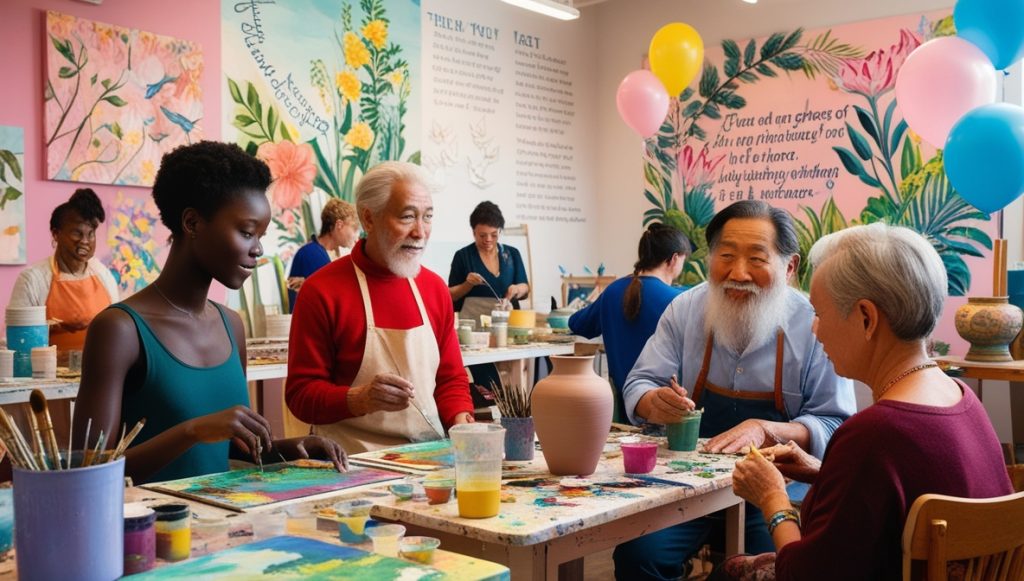Art therapy is a powerful form of healing that combines creative expression with psychological therapy to help individuals manage emotional and psychological challenges. It allows people to explore their thoughts, feelings, and experiences in a non-verbal way, using artistic processes like drawing, painting, sculpting, and other creative activities. Unlike traditional therapy, which often relies on verbal communication, art therapy harnesses creativity to access deeper parts of the mind, helping individuals articulate emotions that may be difficult to express in words.
The Therapeutic Power of Art
Art has long been recognized as a way to process emotions and communicate on a deeper level. Art therapy taps into this natural ability, allowing individuals to explore their feelings in a safe and supportive environment. Creating art can be a cathartic process, as it provides an outlet for emotions that are sometimes too complex or overwhelming to verbalize. Through colors, shapes, and textures, individuals can express trauma, anxiety, depression, and other feelings in ways that words cannot capture.
This form of therapy is especially helpful for people who have experienced trauma, such as abuse or loss, as they may struggle to find the language to talk about their experiences. Art becomes a bridge to self-understanding and healing, offering a new perspective on their challenges and fostering emotional release. As they engage in creative expression, individuals often gain insights into their thoughts and emotions, leading to greater self-awareness and personal growth.
Who Can Benefit from Art Therapy?
Art therapy is a versatile approach that can benefit people of all ages and backgrounds. Children, who may not have the verbal skills to express themselves fully, often find art therapy particularly helpful. It offers a way to communicate their emotions and experiences through play and creative exploration. For children dealing with behavioral issues, trauma, or emotional difficulties, art therapy can provide a means of expression that feels safe and familiar.
Adults, too, can benefit greatly from art therapy, especially those who have difficulty opening up in traditional talk therapy. It’s used in a wide range of therapeutic settings, from hospitals to rehabilitation centers, to treat mental health disorders like anxiety, depression, PTSD, and addiction. Even individuals who do not see themselves as artistically inclined can find the process therapeutic, as the focus is on expression rather than artistic skill.
Art therapy is also widely used with elderly individuals, particularly those dealing with dementia or Alzheimer’s disease. For many seniors, creating art can improve cognitive function, enhance communication, and provide a sense of purpose. In these cases, art therapy is less about processing emotions and more about engaging the mind, improving memory, and enhancing overall well-being.
The Process of Art Therapy
The process of art therapy usually involves a trained art therapist guiding individuals through different creative exercises designed to help them explore their emotions. It may involve drawing, painting, sculpting, collage-making, or other artistic methods. While the therapist may suggest specific activities, the individual ultimately controls the creative process, making choices that reflect their inner state.
The therapist may then engage in dialogue about the artwork, discussing what the individual sees, feels, or experiences while creating it. This reflection helps the individual to make connections between their art and their inner world, fostering deeper understanding and emotional processing. Importantly, the focus is not on the aesthetic quality of the art but on the meaning and emotions behind it.
Benefits of Art Therapy
Art therapy offers a multitude of benefits. It can help reduce stress, improve emotional regulation, enhance self-esteem, and encourage problem-solving and critical thinking. Additionally, it can promote mindfulness, as individuals focus on the creative process and become fully engaged in the present moment.
For many, the act of creating art provides a sense of empowerment and achievement, fostering resilience and hope. Over time, art therapy can lead to lasting emotional healing, offering individuals the tools to cope with future challenges and maintain mental well-being. By tapping into the healing power of creativity, art therapy enables individuals to find balance and peace in their lives.



